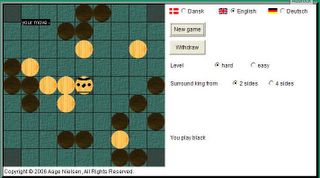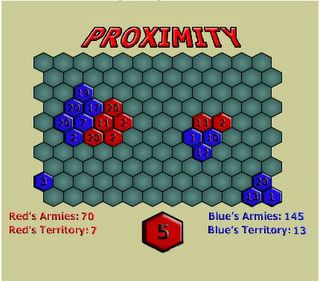Browser Games 4
This week, I am back with a trio of browser games. These are games which you play right in your web browser. This edition is a little different. All three games are two-player abstract strategy games. The first two use Java which is a natural choice. The last one uses Macromedia Shockwave which surprised me a bit. I did not know that Shockwave had the power and efficiency to implement a good min-max algorithm.
Tablut

In my youth, I purchased the book Brain Games by David Pritchard. It contains the rules and a brief introduction to the strategy for the best 33 abstract strategy games in Pritchard's opinion. I ate it up. I was most fascinated by Tablut, a Scandinavian game in Tafl family. I made a simple set and forced my brother and sister to play many games. Tablut is an asymmetric game. The goal of one side to move its king to the edge of the board. The goal of the other side is to stop the king. It is rare that asymmetric games are balanced, but Tablut is pretty close. Each piece moves like a rook in chess with custodian captures. There are a few other minor rules which you can read at their site.
Bridges

Bridges is a classic game similar to hex. You have to form a red path from left-to-right before the computer forms a blue path from top-to-bottom. At each turn, one player turns a white square to their color forming their path and blocking the opponent at the same time. The game is as simple as that. This program plays a strong game. In order words, it kicks my butt. One cute thing about bridges is that a game cannot end in a draw. Ask your favorite mathematician friend for a proof.
Proximity

This is an odd game. After playing it a significant number of times, I still do not understand the strategy. Each turn, you get a piece to play on an empty hex. Neighboring pieces of your color get their values incremented by one. Neighboring pieces of the other color and lesser value are captured and switch to your color. The player with the most hexes at the end wins. The order in which tiles arrive to placed is randomized and secret. This randomness has allowed me to win a couple of games, but I have yet to morally beat the computer. If someone has a good feel for the strategy of Proximity, I would like to know.

1 Comments:
thanks so much for pointing me to this game. It is beautiful.
Actually, I only lost a couple of games at the beginning, then never lost again.
guard your vulnerable spots with your lows.
Post a Comment
<< Home